Tax: Factors for Selecting Accounting Method and Tax Deductions for Ruby Pty Ltd
VerifiedAdded on 2023/06/07
|11
|2631
|52
AI Summary
This article discusses the factors for selecting accounting method and tax deductions for Ruby Pty Ltd under the Australian law. It covers the guidelines of ATO, the difference between perceptible income and exempt income, and the deductable and non-deductable taxes. It also provides suggestions for tax deductions for Ruby Pty Ltd.
Contribute Materials
Your contribution can guide someone’s learning journey. Share your
documents today.
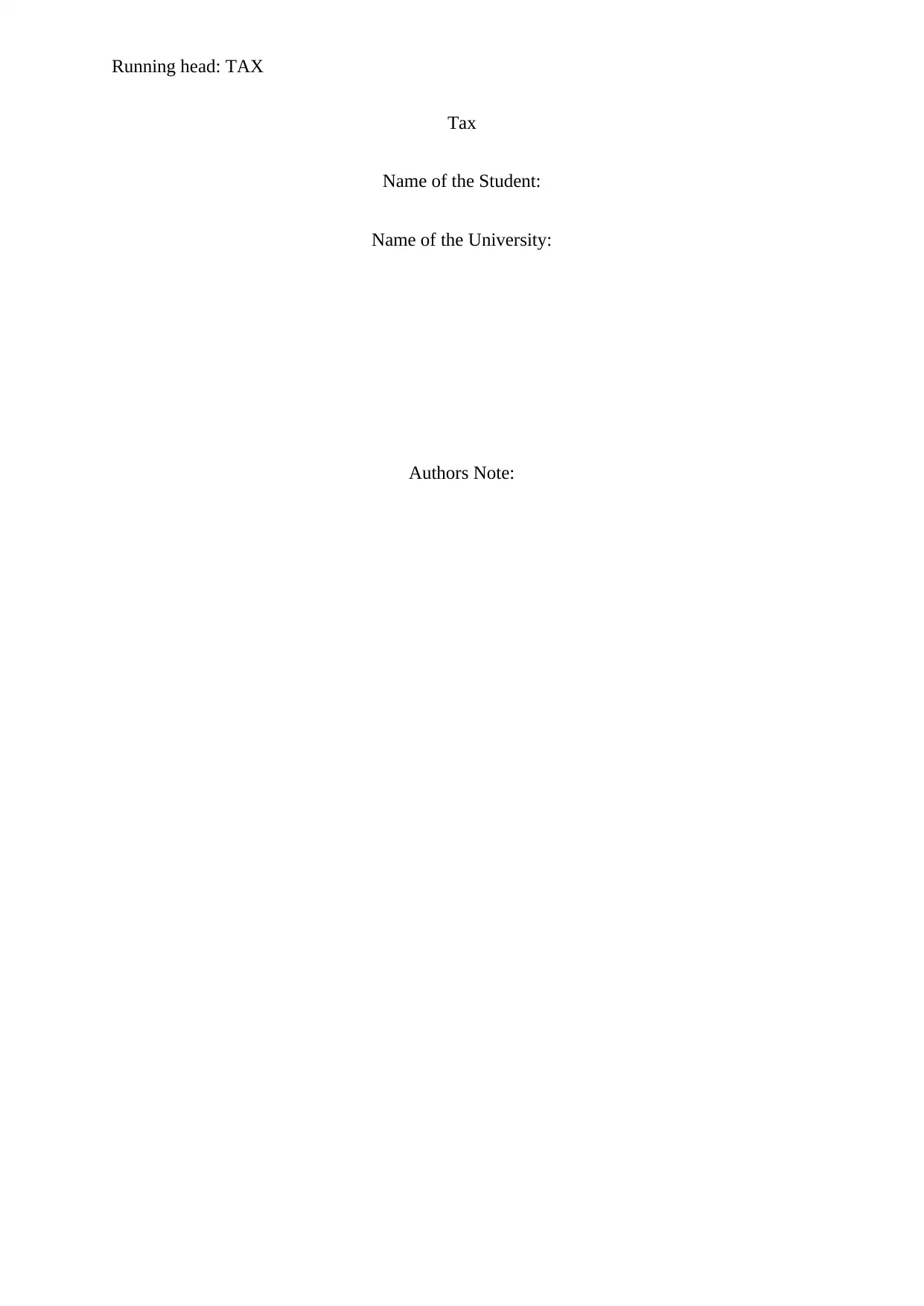
Running head: TAX
Tax
Name of the Student:
Name of the University:
Authors Note:
Tax
Name of the Student:
Name of the University:
Authors Note:
Secure Best Marks with AI Grader
Need help grading? Try our AI Grader for instant feedback on your assignments.
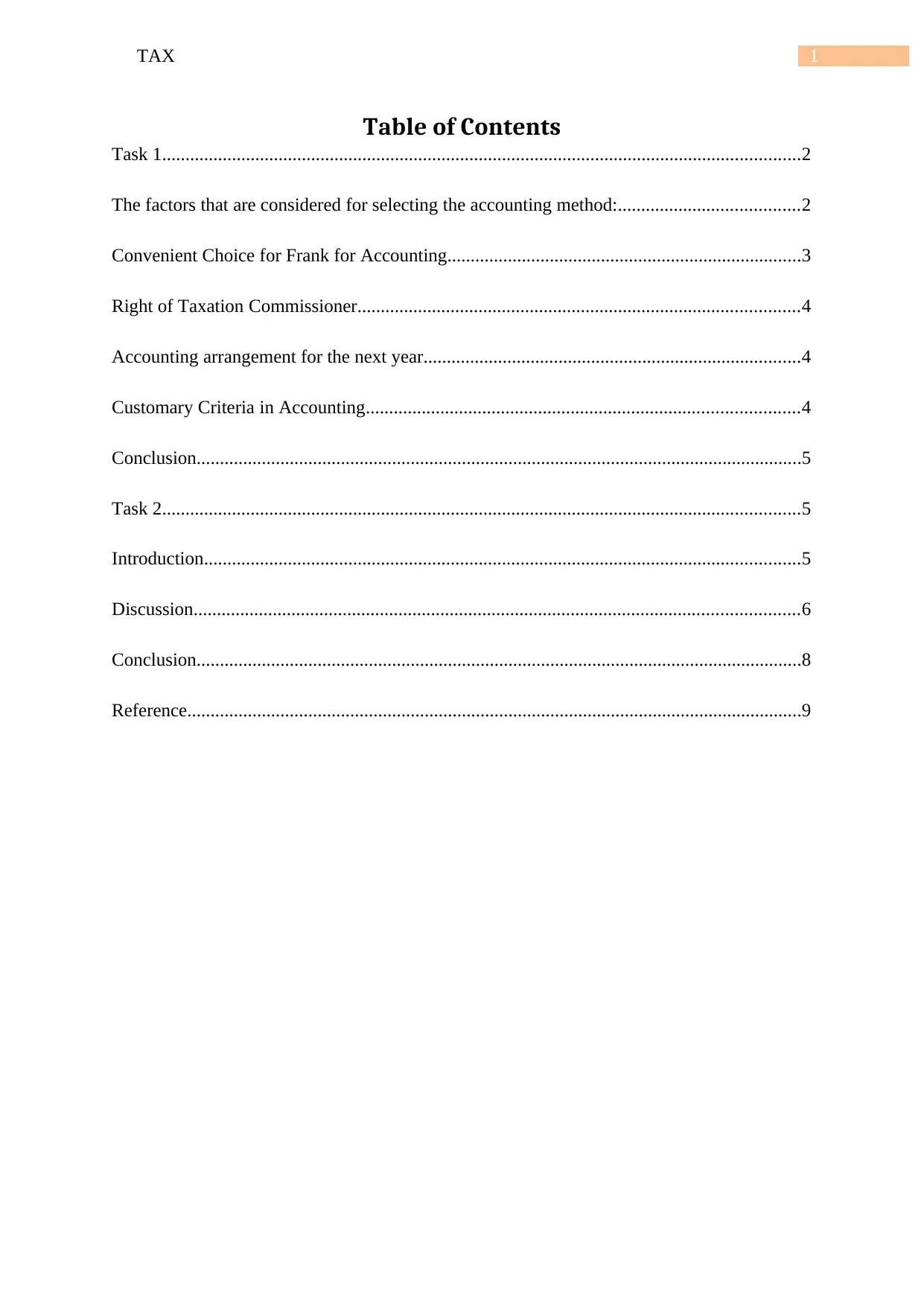
1TAX
Table of Contents
Task 1.........................................................................................................................................2
The factors that are considered for selecting the accounting method:.......................................2
Convenient Choice for Frank for Accounting............................................................................3
Right of Taxation Commissioner...............................................................................................4
Accounting arrangement for the next year.................................................................................4
Customary Criteria in Accounting.............................................................................................4
Conclusion..................................................................................................................................5
Task 2.........................................................................................................................................5
Introduction................................................................................................................................5
Discussion..................................................................................................................................6
Conclusion..................................................................................................................................8
Reference....................................................................................................................................9
Table of Contents
Task 1.........................................................................................................................................2
The factors that are considered for selecting the accounting method:.......................................2
Convenient Choice for Frank for Accounting............................................................................3
Right of Taxation Commissioner...............................................................................................4
Accounting arrangement for the next year.................................................................................4
Customary Criteria in Accounting.............................................................................................4
Conclusion..................................................................................................................................5
Task 2.........................................................................................................................................5
Introduction................................................................................................................................5
Discussion..................................................................................................................................6
Conclusion..................................................................................................................................8
Reference....................................................................................................................................9
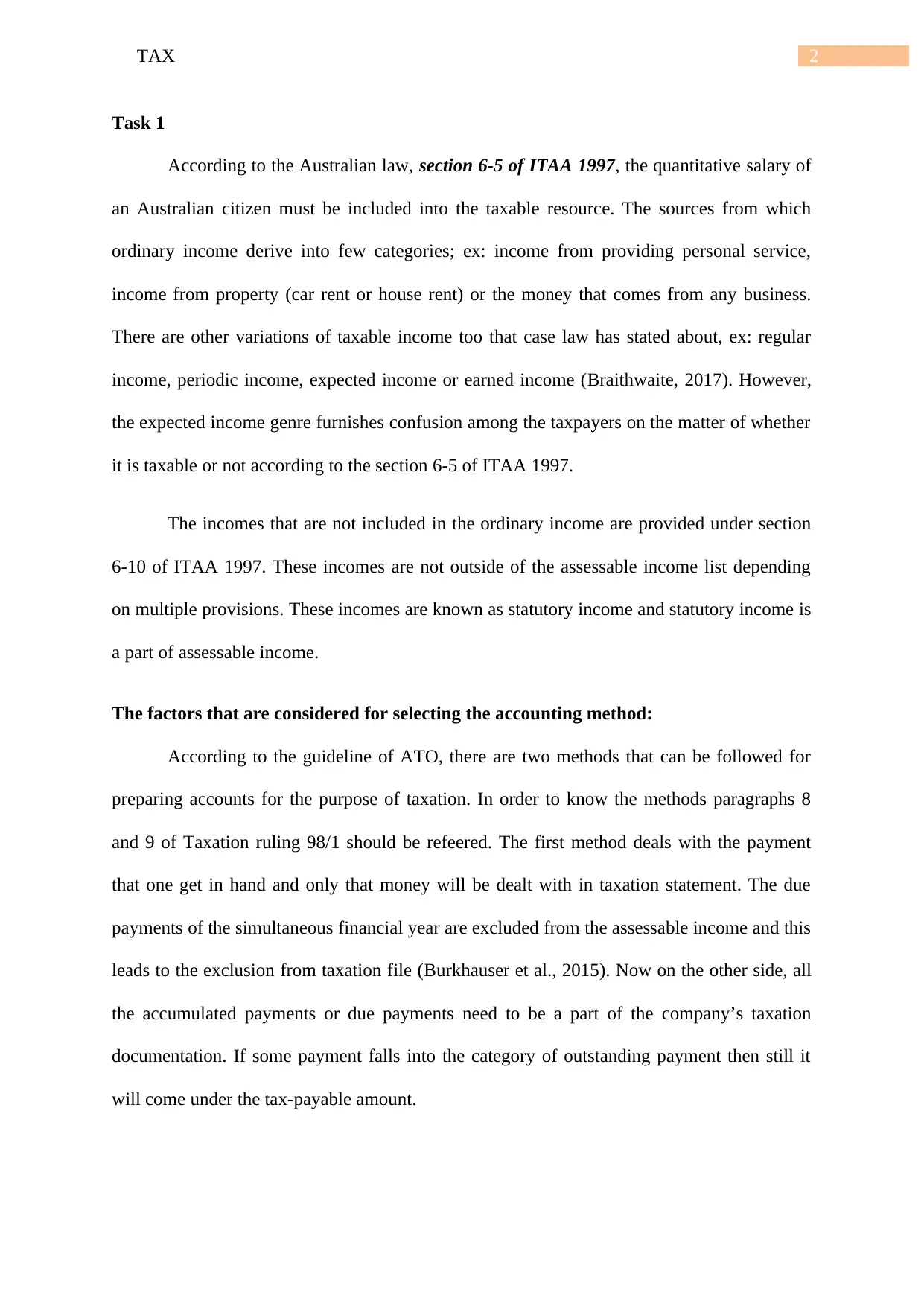
2TAX
Task 1
According to the Australian law, section 6-5 of ITAA 1997, the quantitative salary of
an Australian citizen must be included into the taxable resource. The sources from which
ordinary income derive into few categories; ex: income from providing personal service,
income from property (car rent or house rent) or the money that comes from any business.
There are other variations of taxable income too that case law has stated about, ex: regular
income, periodic income, expected income or earned income (Braithwaite, 2017). However,
the expected income genre furnishes confusion among the taxpayers on the matter of whether
it is taxable or not according to the section 6-5 of ITAA 1997.
The incomes that are not included in the ordinary income are provided under section
6-10 of ITAA 1997. These incomes are not outside of the assessable income list depending
on multiple provisions. These incomes are known as statutory income and statutory income is
a part of assessable income.
The factors that are considered for selecting the accounting method:
According to the guideline of ATO, there are two methods that can be followed for
preparing accounts for the purpose of taxation. In order to know the methods paragraphs 8
and 9 of Taxation ruling 98/1 should be refeered. The first method deals with the payment
that one get in hand and only that money will be dealt with in taxation statement. The due
payments of the simultaneous financial year are excluded from the assessable income and this
leads to the exclusion from taxation file (Burkhauser et al., 2015). Now on the other side, all
the accumulated payments or due payments need to be a part of the company’s taxation
documentation. If some payment falls into the category of outstanding payment then still it
will come under the tax-payable amount.
Task 1
According to the Australian law, section 6-5 of ITAA 1997, the quantitative salary of
an Australian citizen must be included into the taxable resource. The sources from which
ordinary income derive into few categories; ex: income from providing personal service,
income from property (car rent or house rent) or the money that comes from any business.
There are other variations of taxable income too that case law has stated about, ex: regular
income, periodic income, expected income or earned income (Braithwaite, 2017). However,
the expected income genre furnishes confusion among the taxpayers on the matter of whether
it is taxable or not according to the section 6-5 of ITAA 1997.
The incomes that are not included in the ordinary income are provided under section
6-10 of ITAA 1997. These incomes are not outside of the assessable income list depending
on multiple provisions. These incomes are known as statutory income and statutory income is
a part of assessable income.
The factors that are considered for selecting the accounting method:
According to the guideline of ATO, there are two methods that can be followed for
preparing accounts for the purpose of taxation. In order to know the methods paragraphs 8
and 9 of Taxation ruling 98/1 should be refeered. The first method deals with the payment
that one get in hand and only that money will be dealt with in taxation statement. The due
payments of the simultaneous financial year are excluded from the assessable income and this
leads to the exclusion from taxation file (Burkhauser et al., 2015). Now on the other side, all
the accumulated payments or due payments need to be a part of the company’s taxation
documentation. If some payment falls into the category of outstanding payment then still it
will come under the tax-payable amount.
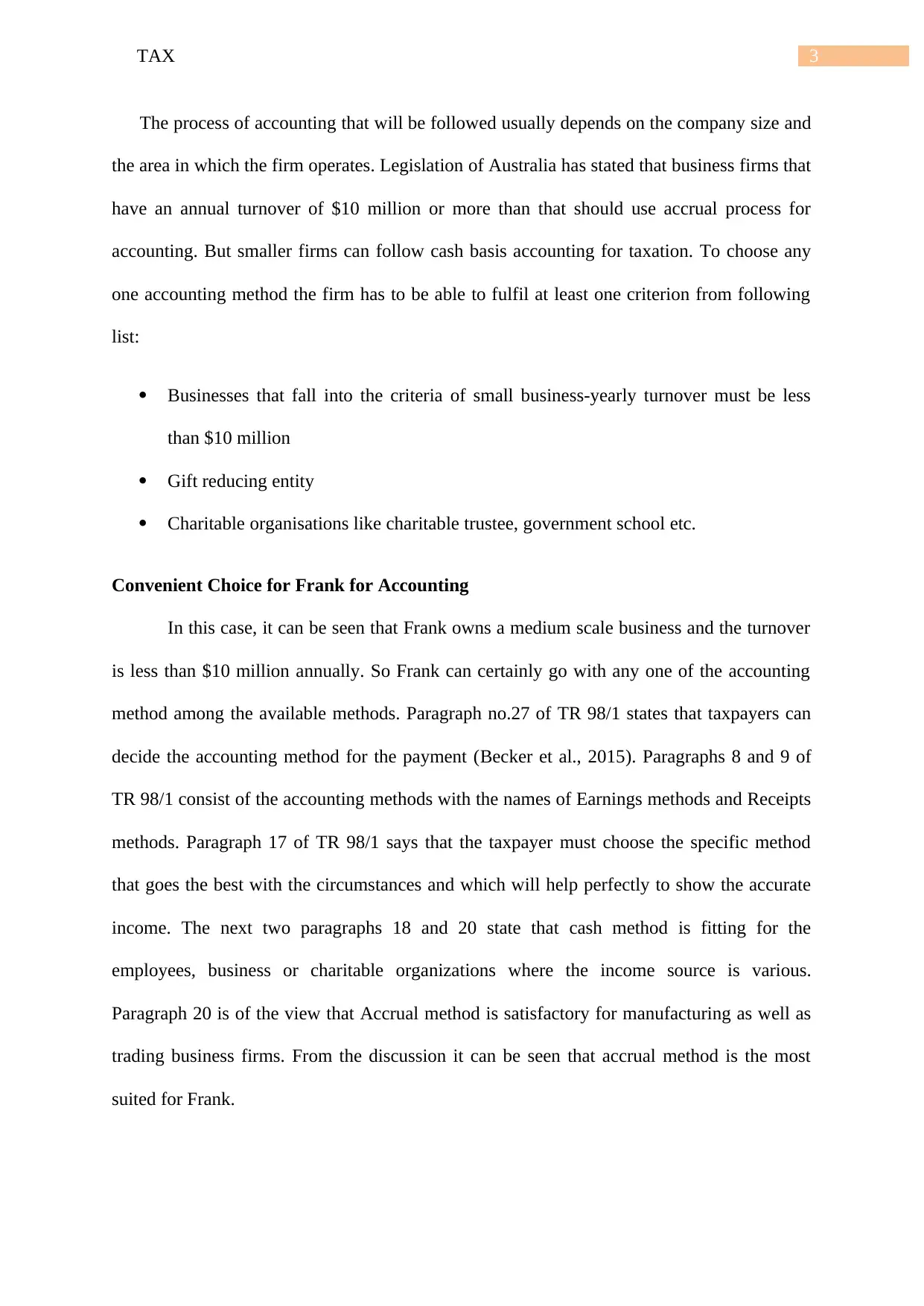
3TAX
The process of accounting that will be followed usually depends on the company size and
the area in which the firm operates. Legislation of Australia has stated that business firms that
have an annual turnover of $10 million or more than that should use accrual process for
accounting. But smaller firms can follow cash basis accounting for taxation. To choose any
one accounting method the firm has to be able to fulfil at least one criterion from following
list:
Businesses that fall into the criteria of small business-yearly turnover must be less
than $10 million
Gift reducing entity
Charitable organisations like charitable trustee, government school etc.
Convenient Choice for Frank for Accounting
In this case, it can be seen that Frank owns a medium scale business and the turnover
is less than $10 million annually. So Frank can certainly go with any one of the accounting
method among the available methods. Paragraph no.27 of TR 98/1 states that taxpayers can
decide the accounting method for the payment (Becker et al., 2015). Paragraphs 8 and 9 of
TR 98/1 consist of the accounting methods with the names of Earnings methods and Receipts
methods. Paragraph 17 of TR 98/1 says that the taxpayer must choose the specific method
that goes the best with the circumstances and which will help perfectly to show the accurate
income. The next two paragraphs 18 and 20 state that cash method is fitting for the
employees, business or charitable organizations where the income source is various.
Paragraph 20 is of the view that Accrual method is satisfactory for manufacturing as well as
trading business firms. From the discussion it can be seen that accrual method is the most
suited for Frank.
The process of accounting that will be followed usually depends on the company size and
the area in which the firm operates. Legislation of Australia has stated that business firms that
have an annual turnover of $10 million or more than that should use accrual process for
accounting. But smaller firms can follow cash basis accounting for taxation. To choose any
one accounting method the firm has to be able to fulfil at least one criterion from following
list:
Businesses that fall into the criteria of small business-yearly turnover must be less
than $10 million
Gift reducing entity
Charitable organisations like charitable trustee, government school etc.
Convenient Choice for Frank for Accounting
In this case, it can be seen that Frank owns a medium scale business and the turnover
is less than $10 million annually. So Frank can certainly go with any one of the accounting
method among the available methods. Paragraph no.27 of TR 98/1 states that taxpayers can
decide the accounting method for the payment (Becker et al., 2015). Paragraphs 8 and 9 of
TR 98/1 consist of the accounting methods with the names of Earnings methods and Receipts
methods. Paragraph 17 of TR 98/1 says that the taxpayer must choose the specific method
that goes the best with the circumstances and which will help perfectly to show the accurate
income. The next two paragraphs 18 and 20 state that cash method is fitting for the
employees, business or charitable organizations where the income source is various.
Paragraph 20 is of the view that Accrual method is satisfactory for manufacturing as well as
trading business firms. From the discussion it can be seen that accrual method is the most
suited for Frank.
Secure Best Marks with AI Grader
Need help grading? Try our AI Grader for instant feedback on your assignments.
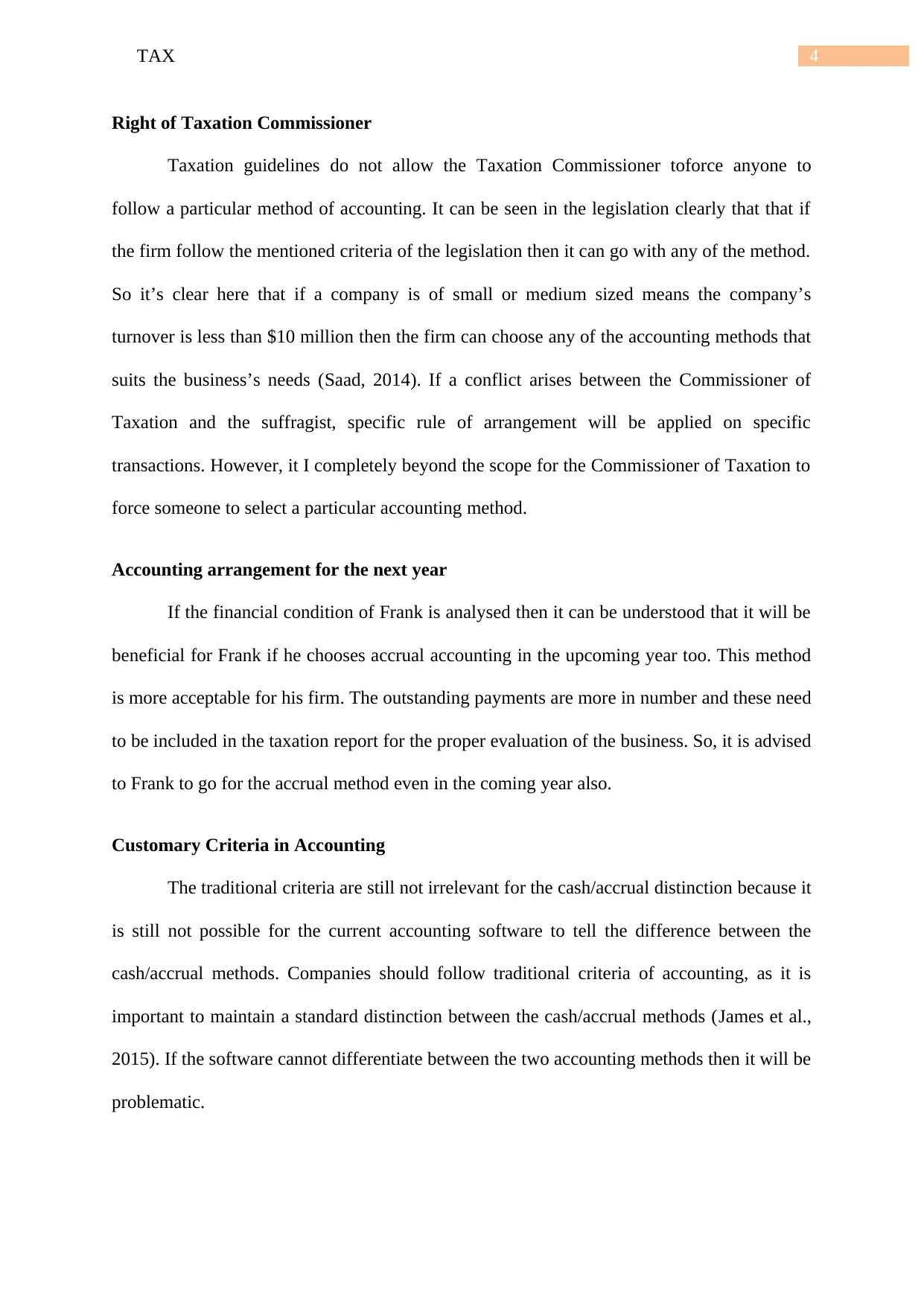
4TAX
Right of Taxation Commissioner
Taxation guidelines do not allow the Taxation Commissioner toforce anyone to
follow a particular method of accounting. It can be seen in the legislation clearly that that if
the firm follow the mentioned criteria of the legislation then it can go with any of the method.
So it’s clear here that if a company is of small or medium sized means the company’s
turnover is less than $10 million then the firm can choose any of the accounting methods that
suits the business’s needs (Saad, 2014). If a conflict arises between the Commissioner of
Taxation and the suffragist, specific rule of arrangement will be applied on specific
transactions. However, it I completely beyond the scope for the Commissioner of Taxation to
force someone to select a particular accounting method.
Accounting arrangement for the next year
If the financial condition of Frank is analysed then it can be understood that it will be
beneficial for Frank if he chooses accrual accounting in the upcoming year too. This method
is more acceptable for his firm. The outstanding payments are more in number and these need
to be included in the taxation report for the proper evaluation of the business. So, it is advised
to Frank to go for the accrual method even in the coming year also.
Customary Criteria in Accounting
The traditional criteria are still not irrelevant for the cash/accrual distinction because it
is still not possible for the current accounting software to tell the difference between the
cash/accrual methods. Companies should follow traditional criteria of accounting, as it is
important to maintain a standard distinction between the cash/accrual methods (James et al.,
2015). If the software cannot differentiate between the two accounting methods then it will be
problematic.
Right of Taxation Commissioner
Taxation guidelines do not allow the Taxation Commissioner toforce anyone to
follow a particular method of accounting. It can be seen in the legislation clearly that that if
the firm follow the mentioned criteria of the legislation then it can go with any of the method.
So it’s clear here that if a company is of small or medium sized means the company’s
turnover is less than $10 million then the firm can choose any of the accounting methods that
suits the business’s needs (Saad, 2014). If a conflict arises between the Commissioner of
Taxation and the suffragist, specific rule of arrangement will be applied on specific
transactions. However, it I completely beyond the scope for the Commissioner of Taxation to
force someone to select a particular accounting method.
Accounting arrangement for the next year
If the financial condition of Frank is analysed then it can be understood that it will be
beneficial for Frank if he chooses accrual accounting in the upcoming year too. This method
is more acceptable for his firm. The outstanding payments are more in number and these need
to be included in the taxation report for the proper evaluation of the business. So, it is advised
to Frank to go for the accrual method even in the coming year also.
Customary Criteria in Accounting
The traditional criteria are still not irrelevant for the cash/accrual distinction because it
is still not possible for the current accounting software to tell the difference between the
cash/accrual methods. Companies should follow traditional criteria of accounting, as it is
important to maintain a standard distinction between the cash/accrual methods (James et al.,
2015). If the software cannot differentiate between the two accounting methods then it will be
problematic.
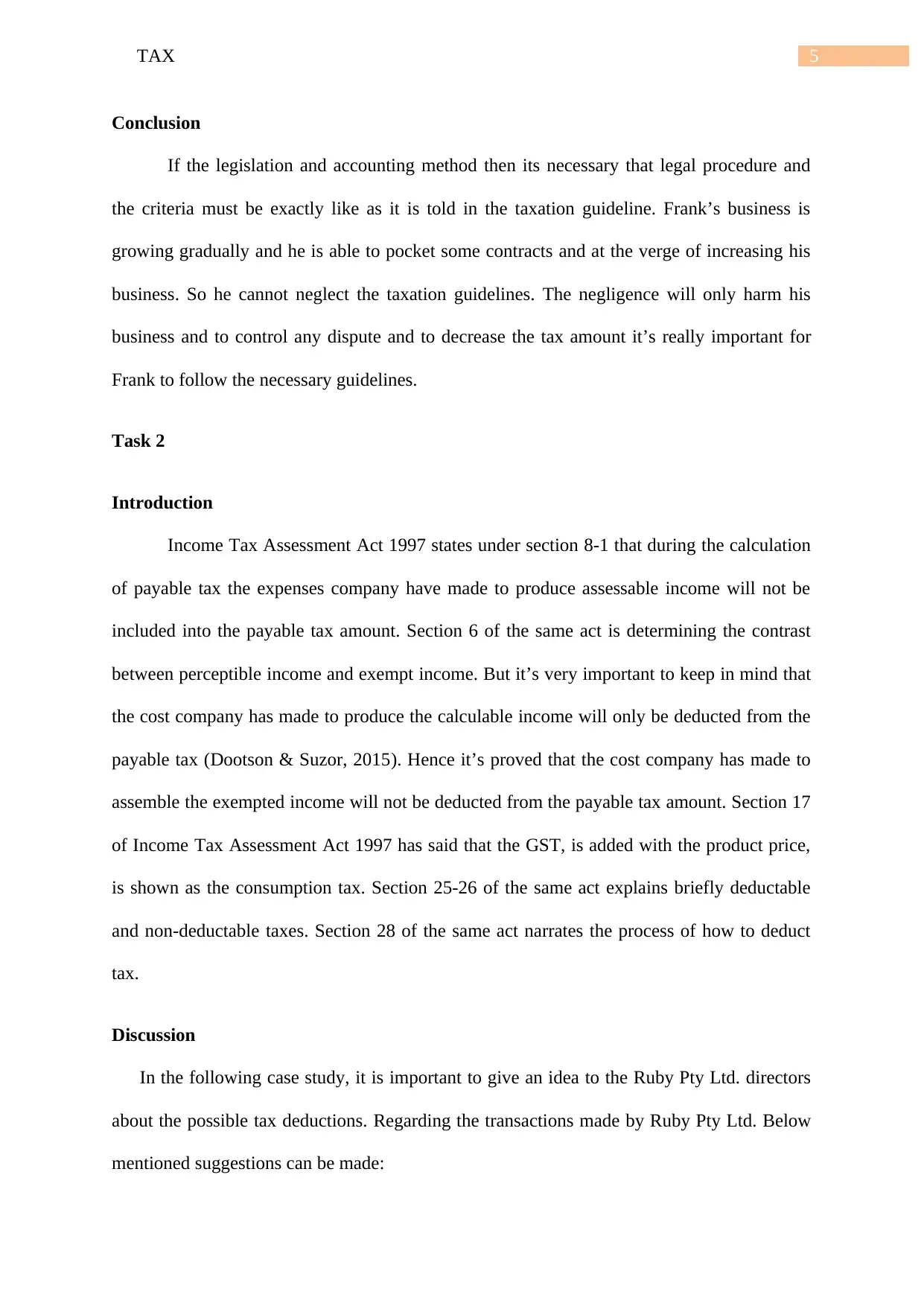
5TAX
Conclusion
If the legislation and accounting method then its necessary that legal procedure and
the criteria must be exactly like as it is told in the taxation guideline. Frank’s business is
growing gradually and he is able to pocket some contracts and at the verge of increasing his
business. So he cannot neglect the taxation guidelines. The negligence will only harm his
business and to control any dispute and to decrease the tax amount it’s really important for
Frank to follow the necessary guidelines.
Task 2
Introduction
Income Tax Assessment Act 1997 states under section 8-1 that during the calculation
of payable tax the expenses company have made to produce assessable income will not be
included into the payable tax amount. Section 6 of the same act is determining the contrast
between perceptible income and exempt income. But it’s very important to keep in mind that
the cost company has made to produce the calculable income will only be deducted from the
payable tax (Dootson & Suzor, 2015). Hence it’s proved that the cost company has made to
assemble the exempted income will not be deducted from the payable tax amount. Section 17
of Income Tax Assessment Act 1997 has said that the GST, is added with the product price,
is shown as the consumption tax. Section 25-26 of the same act explains briefly deductable
and non-deductable taxes. Section 28 of the same act narrates the process of how to deduct
tax.
Discussion
In the following case study, it is important to give an idea to the Ruby Pty Ltd. directors
about the possible tax deductions. Regarding the transactions made by Ruby Pty Ltd. Below
mentioned suggestions can be made:
Conclusion
If the legislation and accounting method then its necessary that legal procedure and
the criteria must be exactly like as it is told in the taxation guideline. Frank’s business is
growing gradually and he is able to pocket some contracts and at the verge of increasing his
business. So he cannot neglect the taxation guidelines. The negligence will only harm his
business and to control any dispute and to decrease the tax amount it’s really important for
Frank to follow the necessary guidelines.
Task 2
Introduction
Income Tax Assessment Act 1997 states under section 8-1 that during the calculation
of payable tax the expenses company have made to produce assessable income will not be
included into the payable tax amount. Section 6 of the same act is determining the contrast
between perceptible income and exempt income. But it’s very important to keep in mind that
the cost company has made to produce the calculable income will only be deducted from the
payable tax (Dootson & Suzor, 2015). Hence it’s proved that the cost company has made to
assemble the exempted income will not be deducted from the payable tax amount. Section 17
of Income Tax Assessment Act 1997 has said that the GST, is added with the product price,
is shown as the consumption tax. Section 25-26 of the same act explains briefly deductable
and non-deductable taxes. Section 28 of the same act narrates the process of how to deduct
tax.
Discussion
In the following case study, it is important to give an idea to the Ruby Pty Ltd. directors
about the possible tax deductions. Regarding the transactions made by Ruby Pty Ltd. Below
mentioned suggestions can be made:
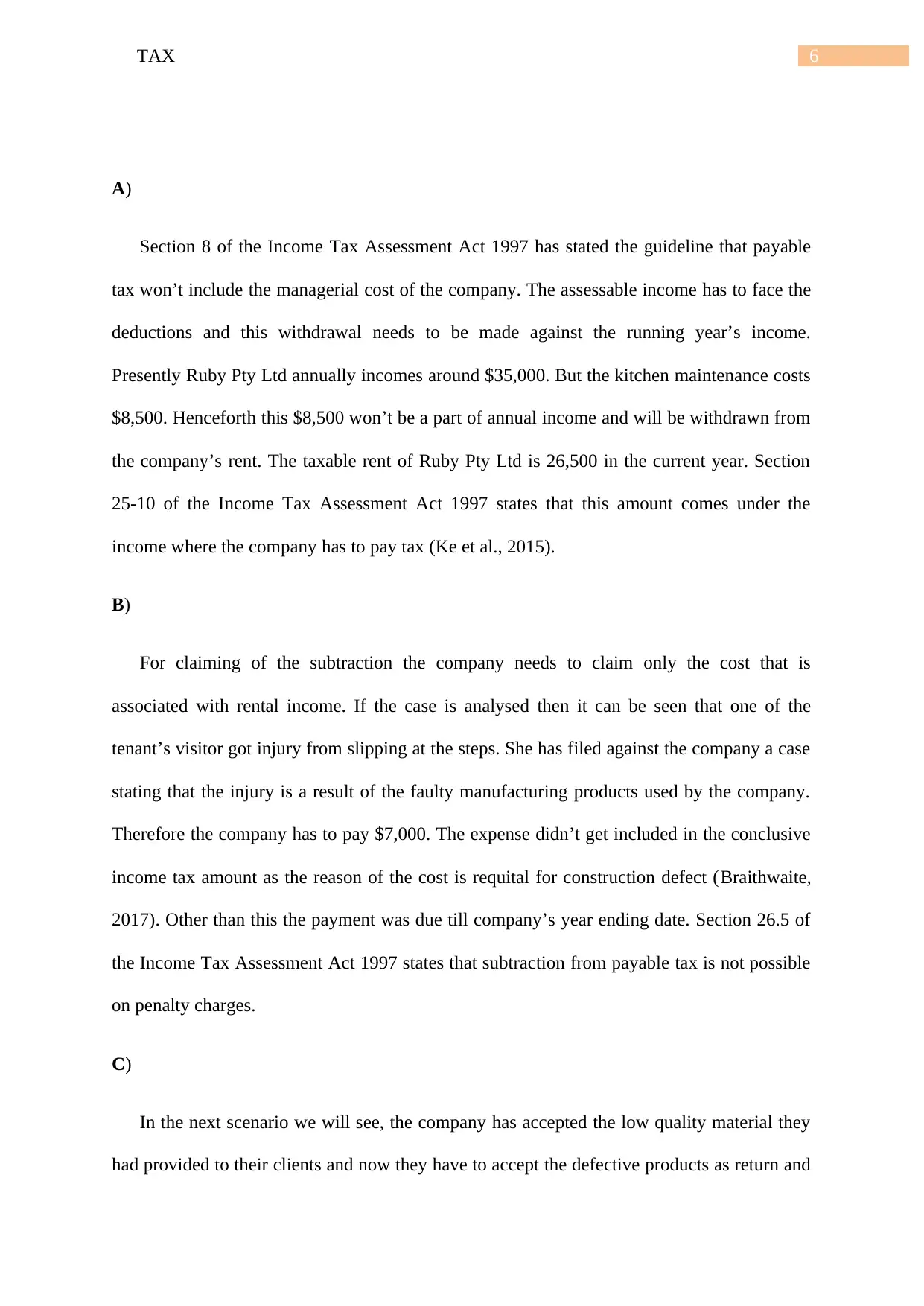
6TAX
A)
Section 8 of the Income Tax Assessment Act 1997 has stated the guideline that payable
tax won’t include the managerial cost of the company. The assessable income has to face the
deductions and this withdrawal needs to be made against the running year’s income.
Presently Ruby Pty Ltd annually incomes around $35,000. But the kitchen maintenance costs
$8,500. Henceforth this $8,500 won’t be a part of annual income and will be withdrawn from
the company’s rent. The taxable rent of Ruby Pty Ltd is 26,500 in the current year. Section
25-10 of the Income Tax Assessment Act 1997 states that this amount comes under the
income where the company has to pay tax (Ke et al., 2015).
B)
For claiming of the subtraction the company needs to claim only the cost that is
associated with rental income. If the case is analysed then it can be seen that one of the
tenant’s visitor got injury from slipping at the steps. She has filed against the company a case
stating that the injury is a result of the faulty manufacturing products used by the company.
Therefore the company has to pay $7,000. The expense didn’t get included in the conclusive
income tax amount as the reason of the cost is requital for construction defect (Braithwaite,
2017). Other than this the payment was due till company’s year ending date. Section 26.5 of
the Income Tax Assessment Act 1997 states that subtraction from payable tax is not possible
on penalty charges.
C)
In the next scenario we will see, the company has accepted the low quality material they
had provided to their clients and now they have to accept the defective products as return and
A)
Section 8 of the Income Tax Assessment Act 1997 has stated the guideline that payable
tax won’t include the managerial cost of the company. The assessable income has to face the
deductions and this withdrawal needs to be made against the running year’s income.
Presently Ruby Pty Ltd annually incomes around $35,000. But the kitchen maintenance costs
$8,500. Henceforth this $8,500 won’t be a part of annual income and will be withdrawn from
the company’s rent. The taxable rent of Ruby Pty Ltd is 26,500 in the current year. Section
25-10 of the Income Tax Assessment Act 1997 states that this amount comes under the
income where the company has to pay tax (Ke et al., 2015).
B)
For claiming of the subtraction the company needs to claim only the cost that is
associated with rental income. If the case is analysed then it can be seen that one of the
tenant’s visitor got injury from slipping at the steps. She has filed against the company a case
stating that the injury is a result of the faulty manufacturing products used by the company.
Therefore the company has to pay $7,000. The expense didn’t get included in the conclusive
income tax amount as the reason of the cost is requital for construction defect (Braithwaite,
2017). Other than this the payment was due till company’s year ending date. Section 26.5 of
the Income Tax Assessment Act 1997 states that subtraction from payable tax is not possible
on penalty charges.
C)
In the next scenario we will see, the company has accepted the low quality material they
had provided to their clients and now they have to accept the defective products as return and
Paraphrase This Document
Need a fresh take? Get an instant paraphrase of this document with our AI Paraphraser
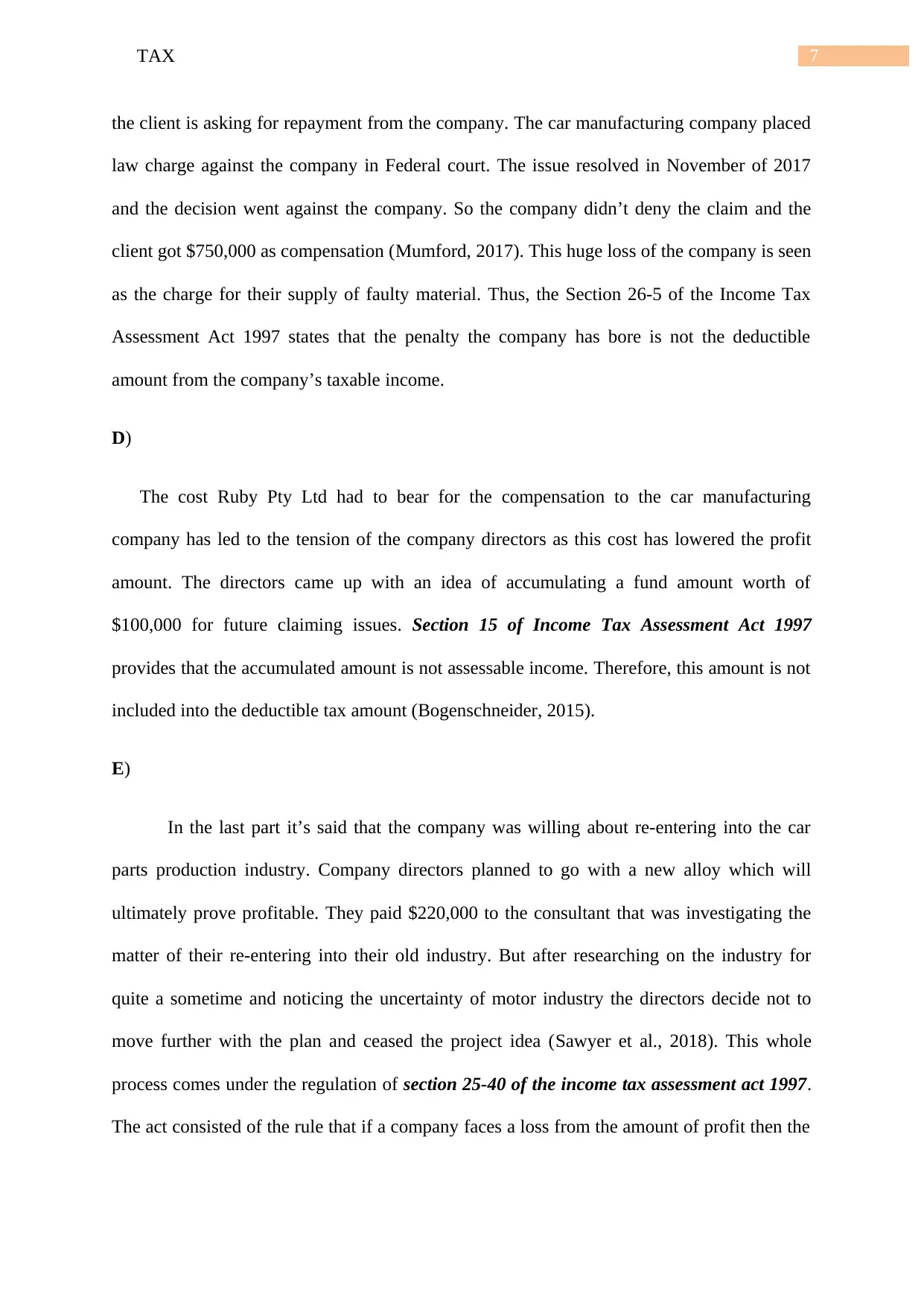
7TAX
the client is asking for repayment from the company. The car manufacturing company placed
law charge against the company in Federal court. The issue resolved in November of 2017
and the decision went against the company. So the company didn’t deny the claim and the
client got $750,000 as compensation (Mumford, 2017). This huge loss of the company is seen
as the charge for their supply of faulty material. Thus, the Section 26-5 of the Income Tax
Assessment Act 1997 states that the penalty the company has bore is not the deductible
amount from the company’s taxable income.
D)
The cost Ruby Pty Ltd had to bear for the compensation to the car manufacturing
company has led to the tension of the company directors as this cost has lowered the profit
amount. The directors came up with an idea of accumulating a fund amount worth of
$100,000 for future claiming issues. Section 15 of Income Tax Assessment Act 1997
provides that the accumulated amount is not assessable income. Therefore, this amount is not
included into the deductible tax amount (Bogenschneider, 2015).
E)
In the last part it’s said that the company was willing about re-entering into the car
parts production industry. Company directors planned to go with a new alloy which will
ultimately prove profitable. They paid $220,000 to the consultant that was investigating the
matter of their re-entering into their old industry. But after researching on the industry for
quite a sometime and noticing the uncertainty of motor industry the directors decide not to
move further with the plan and ceased the project idea (Sawyer et al., 2018). This whole
process comes under the regulation of section 25-40 of the income tax assessment act 1997.
The act consisted of the rule that if a company faces a loss from the amount of profit then the
the client is asking for repayment from the company. The car manufacturing company placed
law charge against the company in Federal court. The issue resolved in November of 2017
and the decision went against the company. So the company didn’t deny the claim and the
client got $750,000 as compensation (Mumford, 2017). This huge loss of the company is seen
as the charge for their supply of faulty material. Thus, the Section 26-5 of the Income Tax
Assessment Act 1997 states that the penalty the company has bore is not the deductible
amount from the company’s taxable income.
D)
The cost Ruby Pty Ltd had to bear for the compensation to the car manufacturing
company has led to the tension of the company directors as this cost has lowered the profit
amount. The directors came up with an idea of accumulating a fund amount worth of
$100,000 for future claiming issues. Section 15 of Income Tax Assessment Act 1997
provides that the accumulated amount is not assessable income. Therefore, this amount is not
included into the deductible tax amount (Bogenschneider, 2015).
E)
In the last part it’s said that the company was willing about re-entering into the car
parts production industry. Company directors planned to go with a new alloy which will
ultimately prove profitable. They paid $220,000 to the consultant that was investigating the
matter of their re-entering into their old industry. But after researching on the industry for
quite a sometime and noticing the uncertainty of motor industry the directors decide not to
move further with the plan and ceased the project idea (Sawyer et al., 2018). This whole
process comes under the regulation of section 25-40 of the income tax assessment act 1997.
The act consisted of the rule that if a company faces a loss from the amount of profit then the
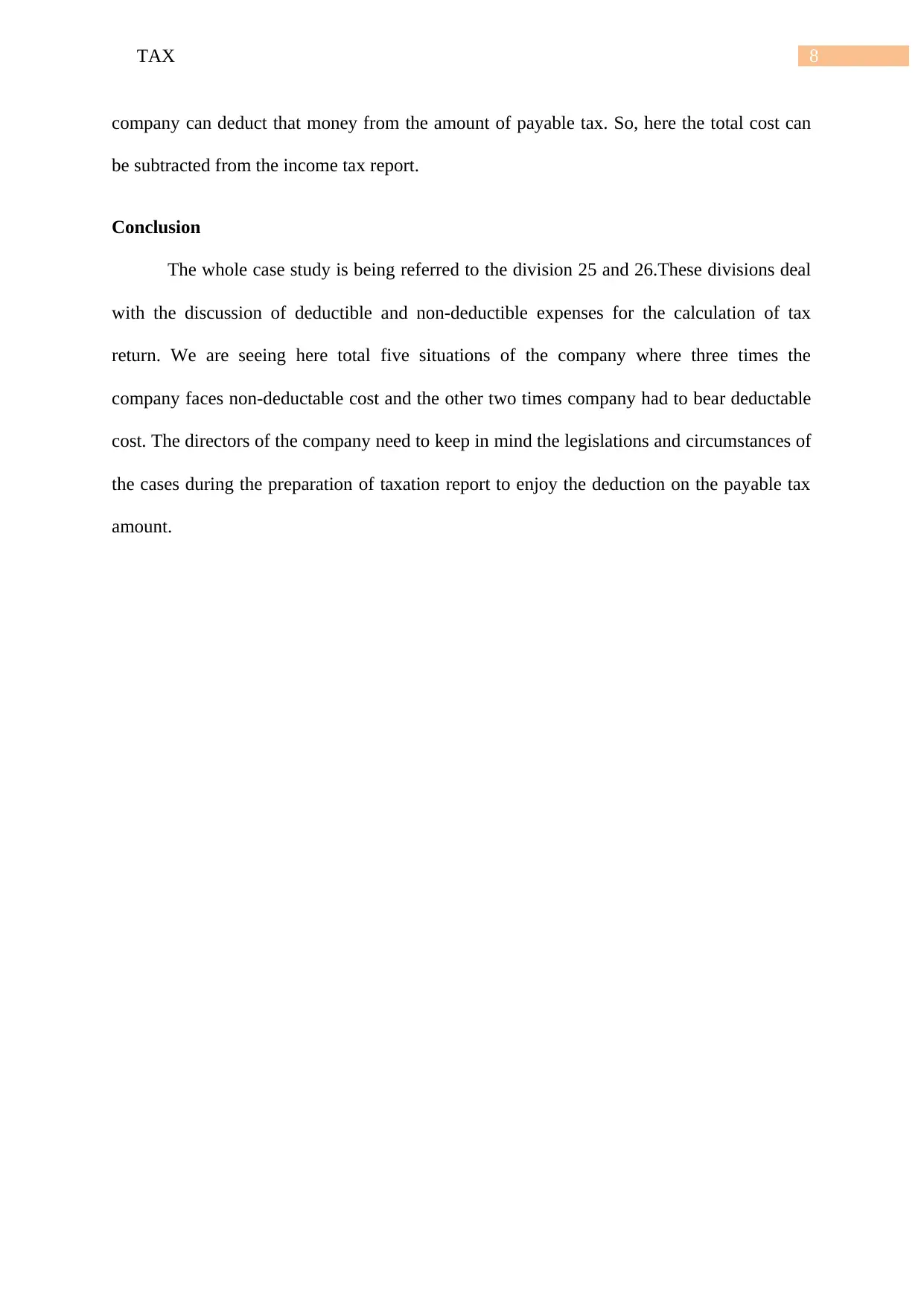
8TAX
company can deduct that money from the amount of payable tax. So, here the total cost can
be subtracted from the income tax report.
Conclusion
The whole case study is being referred to the division 25 and 26.These divisions deal
with the discussion of deductible and non-deductible expenses for the calculation of tax
return. We are seeing here total five situations of the company where three times the
company faces non-deductable cost and the other two times company had to bear deductable
cost. The directors of the company need to keep in mind the legislations and circumstances of
the cases during the preparation of taxation report to enjoy the deduction on the payable tax
amount.
company can deduct that money from the amount of payable tax. So, here the total cost can
be subtracted from the income tax report.
Conclusion
The whole case study is being referred to the division 25 and 26.These divisions deal
with the discussion of deductible and non-deductible expenses for the calculation of tax
return. We are seeing here total five situations of the company where three times the
company faces non-deductable cost and the other two times company had to bear deductable
cost. The directors of the company need to keep in mind the legislations and circumstances of
the cases during the preparation of taxation report to enjoy the deduction on the payable tax
amount.
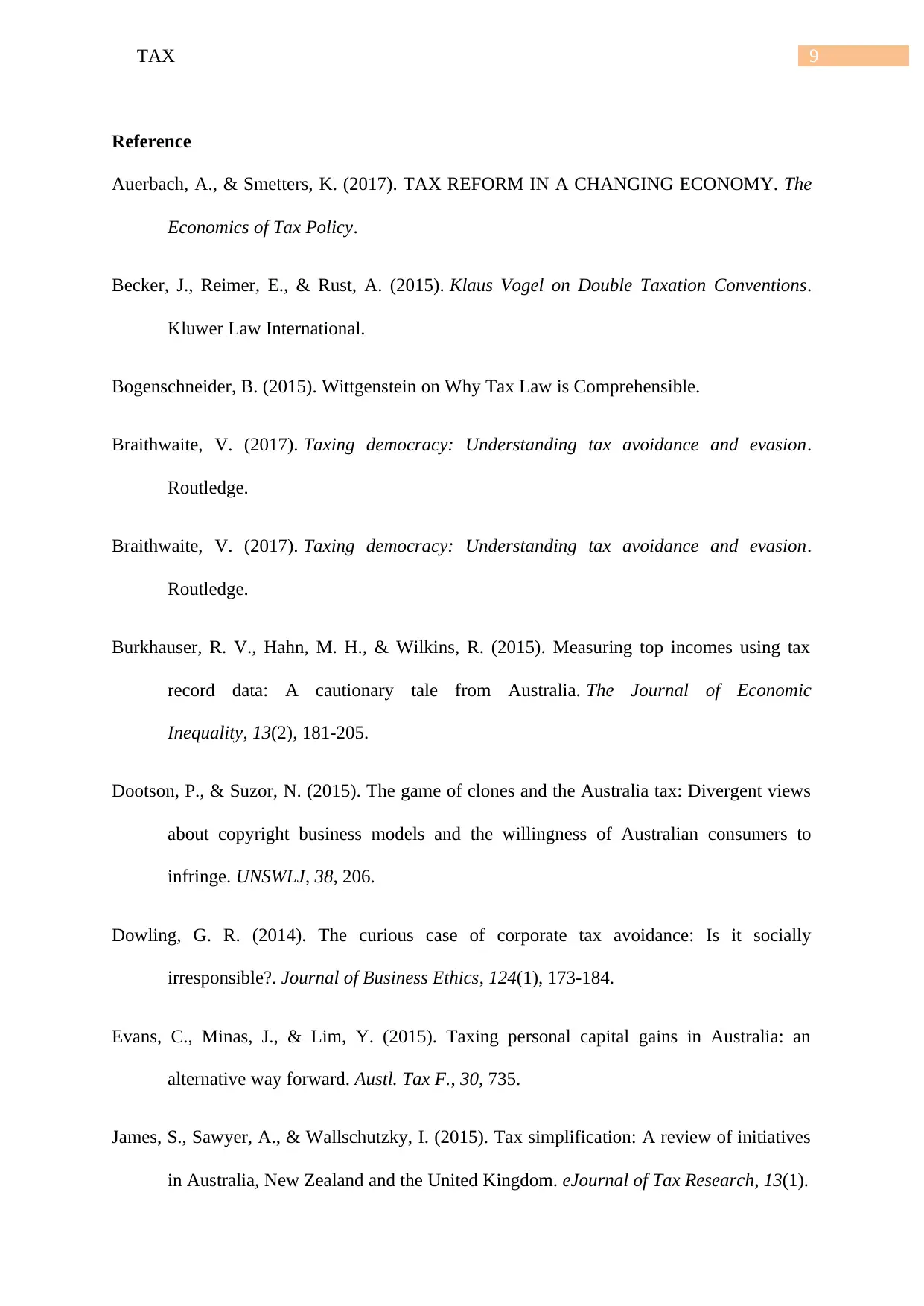
9TAX
Reference
Auerbach, A., & Smetters, K. (2017). TAX REFORM IN A CHANGING ECONOMY. The
Economics of Tax Policy.
Becker, J., Reimer, E., & Rust, A. (2015). Klaus Vogel on Double Taxation Conventions.
Kluwer Law International.
Bogenschneider, B. (2015). Wittgenstein on Why Tax Law is Comprehensible.
Braithwaite, V. (2017). Taxing democracy: Understanding tax avoidance and evasion.
Routledge.
Braithwaite, V. (2017). Taxing democracy: Understanding tax avoidance and evasion.
Routledge.
Burkhauser, R. V., Hahn, M. H., & Wilkins, R. (2015). Measuring top incomes using tax
record data: A cautionary tale from Australia. The Journal of Economic
Inequality, 13(2), 181-205.
Dootson, P., & Suzor, N. (2015). The game of clones and the Australia tax: Divergent views
about copyright business models and the willingness of Australian consumers to
infringe. UNSWLJ, 38, 206.
Dowling, G. R. (2014). The curious case of corporate tax avoidance: Is it socially
irresponsible?. Journal of Business Ethics, 124(1), 173-184.
Evans, C., Minas, J., & Lim, Y. (2015). Taxing personal capital gains in Australia: an
alternative way forward. Austl. Tax F., 30, 735.
James, S., Sawyer, A., & Wallschutzky, I. (2015). Tax simplification: A review of initiatives
in Australia, New Zealand and the United Kingdom. eJournal of Tax Research, 13(1).
Reference
Auerbach, A., & Smetters, K. (2017). TAX REFORM IN A CHANGING ECONOMY. The
Economics of Tax Policy.
Becker, J., Reimer, E., & Rust, A. (2015). Klaus Vogel on Double Taxation Conventions.
Kluwer Law International.
Bogenschneider, B. (2015). Wittgenstein on Why Tax Law is Comprehensible.
Braithwaite, V. (2017). Taxing democracy: Understanding tax avoidance and evasion.
Routledge.
Braithwaite, V. (2017). Taxing democracy: Understanding tax avoidance and evasion.
Routledge.
Burkhauser, R. V., Hahn, M. H., & Wilkins, R. (2015). Measuring top incomes using tax
record data: A cautionary tale from Australia. The Journal of Economic
Inequality, 13(2), 181-205.
Dootson, P., & Suzor, N. (2015). The game of clones and the Australia tax: Divergent views
about copyright business models and the willingness of Australian consumers to
infringe. UNSWLJ, 38, 206.
Dowling, G. R. (2014). The curious case of corporate tax avoidance: Is it socially
irresponsible?. Journal of Business Ethics, 124(1), 173-184.
Evans, C., Minas, J., & Lim, Y. (2015). Taxing personal capital gains in Australia: an
alternative way forward. Austl. Tax F., 30, 735.
James, S., Sawyer, A., & Wallschutzky, I. (2015). Tax simplification: A review of initiatives
in Australia, New Zealand and the United Kingdom. eJournal of Tax Research, 13(1).
Secure Best Marks with AI Grader
Need help grading? Try our AI Grader for instant feedback on your assignments.
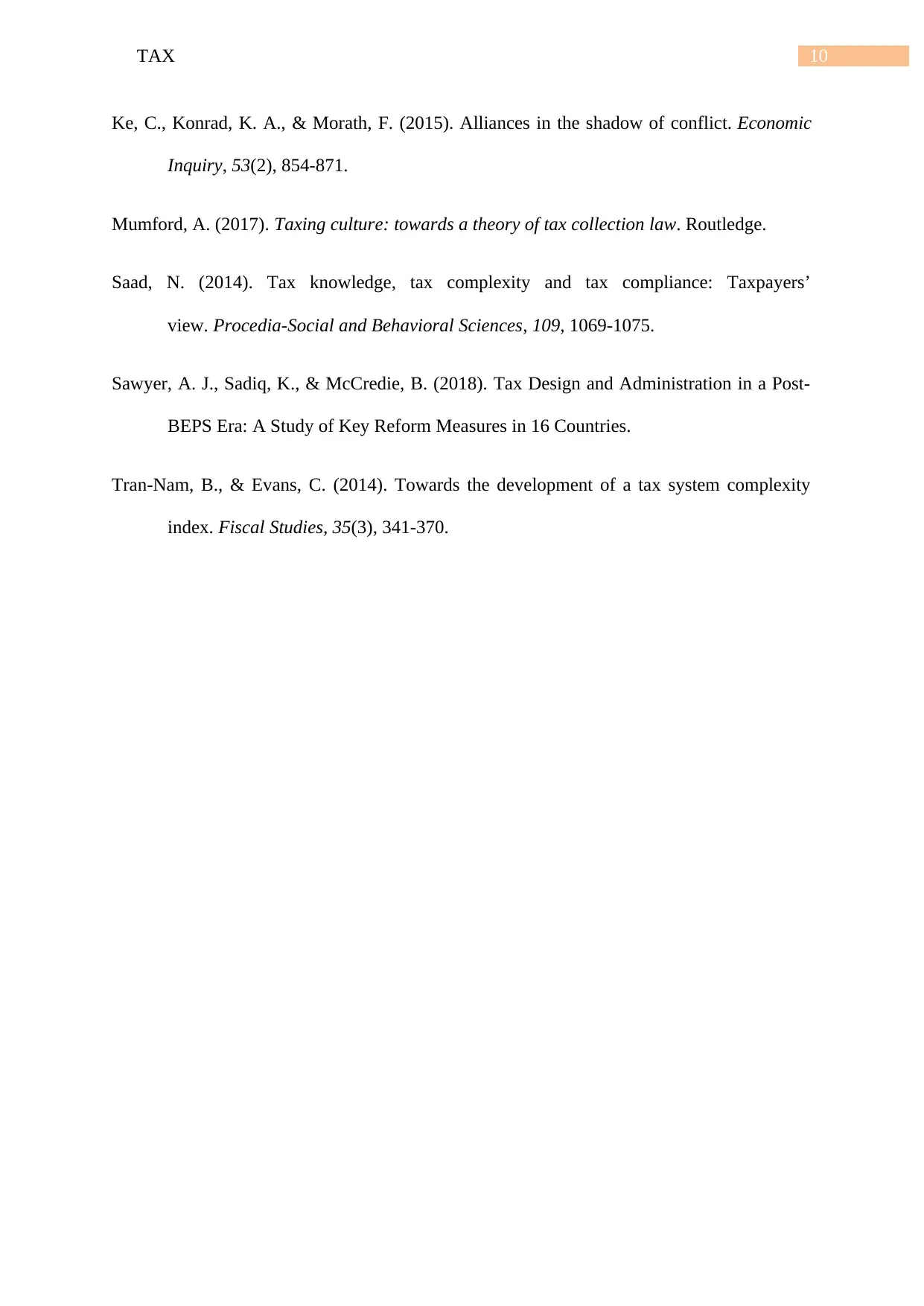
10TAX
Ke, C., Konrad, K. A., & Morath, F. (2015). Alliances in the shadow of conflict. Economic
Inquiry, 53(2), 854-871.
Mumford, A. (2017). Taxing culture: towards a theory of tax collection law. Routledge.
Saad, N. (2014). Tax knowledge, tax complexity and tax compliance: Taxpayers’
view. Procedia-Social and Behavioral Sciences, 109, 1069-1075.
Sawyer, A. J., Sadiq, K., & McCredie, B. (2018). Tax Design and Administration in a Post-
BEPS Era: A Study of Key Reform Measures in 16 Countries.
Tran‐Nam, B., & Evans, C. (2014). Towards the development of a tax system complexity
index. Fiscal Studies, 35(3), 341-370.
Ke, C., Konrad, K. A., & Morath, F. (2015). Alliances in the shadow of conflict. Economic
Inquiry, 53(2), 854-871.
Mumford, A. (2017). Taxing culture: towards a theory of tax collection law. Routledge.
Saad, N. (2014). Tax knowledge, tax complexity and tax compliance: Taxpayers’
view. Procedia-Social and Behavioral Sciences, 109, 1069-1075.
Sawyer, A. J., Sadiq, K., & McCredie, B. (2018). Tax Design and Administration in a Post-
BEPS Era: A Study of Key Reform Measures in 16 Countries.
Tran‐Nam, B., & Evans, C. (2014). Towards the development of a tax system complexity
index. Fiscal Studies, 35(3), 341-370.
1 out of 11
Related Documents
Your All-in-One AI-Powered Toolkit for Academic Success.
+13062052269
info@desklib.com
Available 24*7 on WhatsApp / Email
![[object Object]](/_next/static/media/star-bottom.7253800d.svg)
Unlock your academic potential
© 2024 | Zucol Services PVT LTD | All rights reserved.





